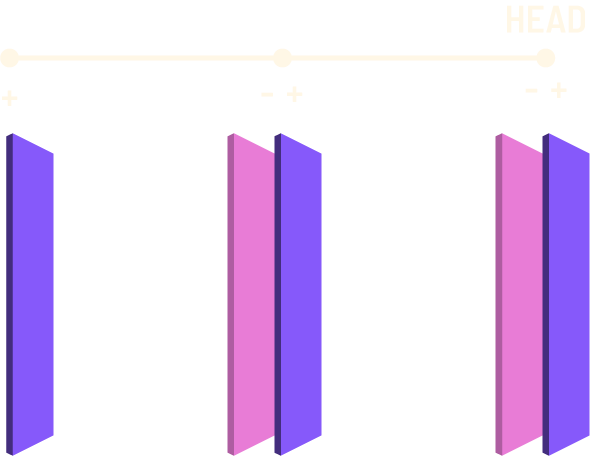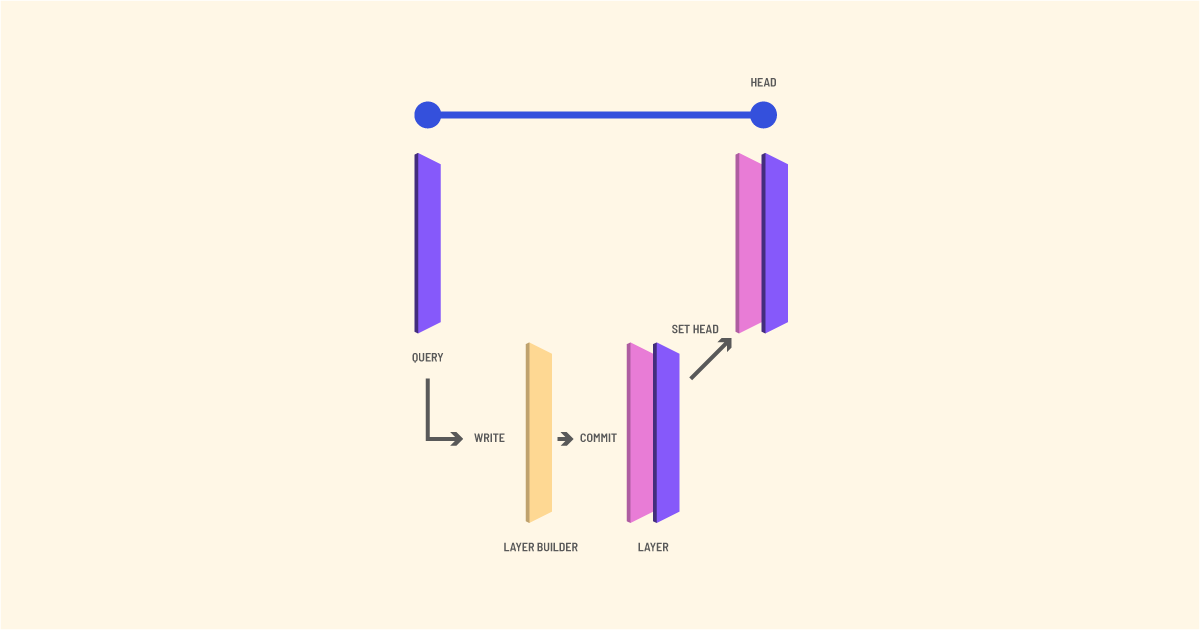Modern hardware architectures include larger main memory and pervasive parallelism. Modern software development processes now incorporate continuous integration/continuous delivery (CI/CD) coupled with revision control. These fundamental changes to information technology infrastructure necessitate a re-appraisal of database architecture. TerminusDB makes a radical departure from historical architectures to address these changes. First, we implement a graph database with a strong schema so as to retain both simplicity and generality of design. Second, we implement this graph using succinct immutable data structures which enablemore sparing
use of main memory resources. Prudent use of memory reduces cache contention while read only data structures simplify parallel access significantly. Third, we adopted the delta encoding approach
to updates as is used in source control systems such as git. This provides transaction processing and updates to our immutable database data structures, recovering standard database management
features while also providing the whole suite of revision control features: branch, merge, squash, rollback, blame, and time-travel facilitating CI/CD approaches on data.
1. Introduction
There has been an explosion of new database designs, including graph databases, key-value stores, document databases, andmulti-model databases. Yet the majority of production databases are still based on the RDBMS designs of the 1970s(Codd, 1970). This has become a bottleneck in an increasingly automated modern technology operations environment.
Meanwhile, both hardware infrastructure and software design process have moved on significantly over the course of the last 40 years. In particular, machines with terrabytes of RAM are now available for prices reasonable enough for some small and medium sized enterprises.
At the same time, flexible revision control systems have revolutionised the software development process. The maintenance of histories, of records of modification and the ability to roll back enables engineers to have confidence in making modificiations collaboratively. This is augmented with important features such as branching, labelling, rebasing, and cloning. When combined with continuous integration/continuous delivery (Kaiser, Perry, & Schell, 1989 (Laukkanen, Itkonen, & Lassenius, 2017) (CI/CD) teams of programmers can have confidence that central repositories are maintained in correct states such that they can be safely deployed once testing and verification have been passed.
These two developments suggest a solution at their intersection. Namely, the use of in-memory immutable succinct data structures and deltas as used in revision control systems. TerminusDB demonstrates how these features can be combined to produce a flexible transactional graph database.
2. Design
TerminusDB is a fully featured graph database management system (GDBMS) with a rich query language: WOQL (the Web Object Query Language). However, we restrict our attention here to the underlying data structure design and layout which we have implemented in a Rust(Blandy, 2015) library that we call terminus-store.
We describe in turn the graph database model which is used, the succinct data structure approach, and finally how we implement revision control type operations using deltas which we collect together with some metadata into objects which we term layers.
2.1 Graph Databases
Graph databases are one of the fastest-growing new database paradigms. Since graphs are very general it is possible to render many database modeling techniques in a graph database. The simplicity and generality of graphs make them a good candidate for a general-purpose delta encoded approach to an online transaction processing database.
The TerminusDB infrastructure is based on the RDF standard. This standard specifies finite labeled directed graphs which are parametric in some universe of datatypes. The names for nodes and labels are drawn from a set of IRIs (Internationalized Resource Identifiers). For TerminusDB we have chosen the XSD datatypes as our universe of concrete values.
More formally, in TerminusDB a graph G is a set of triples drawn from the set IRI x IRI x (IRI ⊗ XSD) where IRI is a set of valid IRIs and XSD is the set of valid XSD values. While some RDF databases allow a multiplicity of triples (i.e. a bag), the choice of a set simplifies transaction processing in our setting.
For schema design, TerminusDB uses the OWL language with two modifications to make it suitable as a schema language. Namely, we dispense with the open world interpretation and insist on the unique name assumption(Feeney, Mendel-Gleason, & Brennan, 2018). This provides us with a rich modeling language that can provide constraints on the allowable shapes in the graph.
TerminusDB, following on from the RDF tradition, is not a property graph. However, OWL extends RDF graphs with powerful abstractions such as classes, restrictions, and strongly typed properties. We can choose to interpret objects as either nodes or relationships as we please. In a logical sense, property graphs are equivalent to a single view of a more expressive OWL graph. This choice leads to a simplification of the underlying representation, which, as we will see, is important when constructing succinct data structures with change sets.
Here’s an article to help that discusses patterns and principles for graph schema design in TerminusDB
2.2 Succinct Data Structures
Succinct data structures(Jacobson, 1988) are a family of data structures which are close in size to the information theoretic minimum representation. Technically, they can be defined as data structures whose size is:
n + o(n)
Where n is the information theoretic minimum size. Succinct representations are generally somewhat more computationally expensive than less compact representations with pointers when working with small datasets. However, as the size of the data structure grows, the ability to avoid new cache reads at various levels of the memory hierarchy (including reading information from disk) means that these representations can prove very speed competitive(Gog & Petri, 2014) in practice.
TerminusDB largely borrows its graph data structure design from HDT(Martínez-Prieto, Arias Gallego, & Fernández, 2012) with some modifications which simplify the use of change sets. The authors originally evaluated HDT as a possibility for a graph that was too large to fit in memory when loaded into PostgreSQL and found that queries on the resulting graph performed much better in HDT(Mendel-Gleason et al., 2018).
In particular, the primary data structures of the HDT format are retained, namely front coded dictionaries, bit sequences, and wavelet trees.
2.2.1 Plain Front-Coding Dictionary
| String | Offset | Remainder |
| Pearl Jam | 0 | Pearl Jam |
| Pink Floyd | 1 | ink Floyd |
| Pixies | 2 | xies |
| The Beatles | 0 | The Beatles |
| The Who | 4 | Who3 |
Table 1: Plain Front-Coding
Due to the unusual quantity of shared prefixes found in RDF data due to the nature of URIs and IRIs, front-coding provides a fast dictionary format with significant compression of data(Martínez-Prieto, Brisaboa, Cánovas, Claude, & Navarro, 2016).
The primary operations exposed by the data structure are string-id which gives us a natural number corresponding with the string, and id-string, which gives a string corresponding with a natural number.
The data structure sorts the strings and allows sharing of prefixes by reference to the number of characters from the preceding strings which are shared. An example is given in Table 1. The position in the dictionary gives us the implicit natural number identifier.
2.2.2 Succinct Graph Encoding
| Triples | Encoding | Description |
| (1,2,3) | 1 2 3 | Subject Ids |
| (1,2,4) | 1 1 0 1 | Encoded Subject Bit Sequence |
| (2,3,5) | 2 3 4 5 | Predicate Vector |
| (2,4,6) | 1 0 1 1 1 | Encoded Predicate Bit Sequence |
| (3,5,7) | 3 4 4 5 6 | Object Vector |
Table 2: Succinct Graph Representation
Once subject, object, and property of an edge have been appropriately converted into integers by use of the subject-object dictionary, the value dictionary, and the predicate dictionary, we can use these integers to encode the triples using bit sequences.
Succinct sequences encode sequences drawing from some alphabet σ. In the case of a bit-sequence, σ = {0; 1}. They typically expose (at least) the following
primitives:
- rank(a; S; i) which counts occurrences of a in the
sequence from S[0; i]. - select(a; S; i) which returns the location of the i-th
occurrence of a in the sequence S. - access(S; i) which returns the symbol at S[i].
Given a sorted set of triples for each subject identifier in order from {0::n} where n is the number of triples, we emit a 1 followed by a 0 for every predicate associated in a triple with that subject. We then produce a vector of all predicates used and the association with the subject is apparent from the position of zeros in the bit sequence.
We repeat the process for predicates and objects resulting in a complete encoding for our triples. We can see an example in Table 2. We have written the vectors in this table so that the triples are vertically aligned, with subjects in blue, predicates in red, and objects in green in order to make the encoding easier to see. The subject identifiers are actually implicit in the number of 1s encoded in the subject bit sequence and are only written in the table for clarity.
This format allows fast lookup of triples based on query modes in which the subject identifier is known, as we can use select to find the position in the predicate vector and subsequently use the predicate identifier to select in the object vector. We use a wavelet tree to enable search starting from the predicate. Details of this can be found in (Martínez-Prieto et al., 2012).
2.3 Delta Encoded Databases
The use of delta encoding in software development is now ubiquitous due to the enormous popularity of the Git revision control system which makes use of these techniques to store histories of revisions.
Git stores objects which contain either the complete dataset of interest or the information about what is updated (deleted/added) as a delta. All changes to the source control system are thereby simply management problems of these objects.
This approach exposes a number of very powerful operations to software developers collaborating on a code base. The operations include:
- History: Since new updates are actually layered over previous ones, developers can time travel, looking into the past, rolling back to the past, or even reapplying changes to current versions.
- Branching: Developers can create a derived version of a given code-base where additional operations can be performed without disrupting the original.
- Merging: When two branches diverge, the changes can be merged into a single version by choosing a strategy for combining changes.
These features have powered a revolution in software engineering and have elevated the importance of DevOps automation in modern IT infrastructures. It would be nice if we could apply them to databases too and similarly elevate the field of data-ops. However, git itself is not the solution – Git is squarely focused on code management, and data and code differ in some important fundamental characteristics.
Codebases can be adequately modeled as a hierarchy of directories containing files, with changes modeled as the addition or subtraction of lines of text to these files. Databases, by contrast, lack a universal navigation and addressing mechanism like the filesystem. They often have complex internal structures which govern the granularity of updates. They cannot usefully be reduced to the same universal unit of comparison as used by code: the line of text. Given that databases can be many times larger than even the biggest code-base, the fineness of the granularity of diffs is an important performance factor.
TerminusDB uses nodes and edges, replete with classes and restrictions to model the structure of data – enabling a fine granularity in expression of changes. Otherwise, it uses a similar approach to git for expressing updates. A given database is comprised of layers that stand in place of the objects of git. Each layer is identified by a unique 20-byte name. The base layer contains a simple graph represented using the succinct data structures described earlier.
Above this layer, we can have further layers. Each additional layer above the base layer is comprised of additional dictionaries for newly added subjects and objects, predicates, or values. It also contains the index structures used for the base graph to represent positive edges that have been added to the graph. And we have a membership set of negative edges which describe those triples which have been deleted as shown in Figure 1.

Each layer has a pointer to the previous layer which is achieved by referring to its 20-byte name.
This immutable chain structure allows for straightforward uncoordinated multi-read access sometimes called multiversion concurrency control (MVCC)(Mohan, Pirahesh, & Lorie, 1992)(Sadoghi, Canim, Bhattacharjee, Nagel, & Ross, 2014). This approach also makes branching simple to implement. Any number of new layers can point to the same former parent layer.
In order to manage these layers as datastores, we use a label. A label is a name that points to one of the 20-byte identifiers. In the present implementation, this is a file with the name of the label containing the 20-byte identifier.
2.3.1 Dictionary modifications
Due to the use of delta encodings, new triples can be added which are not present in the original dictionary. We, therefore, start new dictionaries with a recorded offset, remembering the last bucket from the previous dictionary.
2.4 Write Transactions
When an update transaction is initiated, a new layer builder is created, which logs all newly inserted or deleted edges. When this layer builder is committed, it yields a layer that has organized the insertions in our succinct data structures.
In TerminusDB we require that graphs conform to the constraints imposed by the OWL description of the dataset. This means that we produce a hypothetical database by committing the layer builder without advancing head. First, we check that the constraints hold on this new intermediate database. After these are passed, it is safe to advance head to this newly created layer. Advancing is done by side-effecting the label to point to the new 20-byte value. The problem of coordination in the face of side-effects is reduced to the problem of label management, simplifying much of the architecture. A schematic of the workflow of the write transaction is given in Figure 2.

Automated checking of data constraints is particularly important if we are to confidently merge database branches that might have divergent schemas or mutually inconsistent states (e.g. where we have a property with a cardinality of exactly one in both branches, but with a different value in each). At a minimum, we need to ensure that merging branches does not result in the database entering an inconsistent state and hence, although constraint checking is beyond the scope of this paper, it is a critical piece of the puzzle in enabling automated data-ops(Mendel-Gleason, 2018).
2.5 Delta compression
As new updates are performed the database layer depth increases. This will incur a performance penalty requiring repeated searching at each layer for every query. In order to improve performance, we can perform a delta compression similar to the mechanisms used in git. Alternatively, we can recalculate the full dataset as a new base-layer. In git, this delta compression step can be performed manually, or it will occur when a depth threshold is passed.
Since the layers are immutable, this operation can be done concurrently. Commits that occur before the process is completed simply layer over the delta with no visible change in the content of the database.
Compressed deltas of this type can allow older layers to be archived, or even deleted. The removal of previous layers removes the capacity to time travel or to track whether the database arose from a branch.
However, this information can be kept separately in a metadata repository allowing the memory of the branching structure and other information about previous commits, but not the capacity to time-travel to them. We plan to implement this graph metadata repository in future version of TerminusDB.
3 Future Work
Values are stored as strings using a plain front coding dictionary uniformly for all data types. Obviously, this is less than ideal in that it causes an expansion in size for the storage of integers, dates, and other specific types. It also means that only search from the beginning of the datatype is optimized. In future versions of Terminus-store, we hope to differentiate our indexing strategies for the various datatypes in XSD.
For strings, the use of succinct data structure immediately suggests a potential candidate: the FMindex(Ferragina & Manzini, 2005). With FM-indexing, very large datasets could still have reasonable query times for queries that are typically done on full-text indexes using inverted term-document indexing. We have yet to explore the candidates for numeric and date types.
Currently, the tracking of history and branches is implicit. We intend to adopt a more explicit approach, storing a graph of the various commits coupled with timestamps and other metadata which will facilitate effective management.
4 Conclusion
The use of advanced CI/CD workflows for databases as yet has not been practical due to the lack of tool-chain support. In the software world, we have seen just what
a large impact appropriate tools can make with the advent of Git.
TerminusDB makes possible these collaborative CI/CD type operations in the universe of data management. This is made possible because of the synergies which
an immutable layered approach has with the succinct data structure approach that we have used for encoding.
TerminusDB provides a practical tool for enabling branch, merge, rollback, and the various automated and manual testing regimes which they facilitate on a transactional database management system that can provide sophisticated query support.
5 Addional Notes
This whitepaper was originally written and published on January 14th, 2020 by Matthijs van Otterdijk, Gavin Mendel-Gleason, and Kevin Feeney. To understand how TerminusDB has evolved, please see the three-part TerminusDB Internals series.

TerminusDB Internals
Part 1 of TerminusDB Internals, looks at the guts and how we’ve built an in-memory graph database to avoid thrashing and slow performance.

TerminusDB Internals Part 2
Part 2 of TerminusDB Internals looks at how we deal with mutating data with succinct data structures and graph storage.

TerminusDB Internals Part 3
Part 3 of TerminusDB Internals looks at how we sort data lexically and how we have overcome some of the issues that come with this approach.
Bibliography
Blandy, J. (2015). The rust programming language: Fast, safe, and beautiful. O’Reilly Media, Inc.
Codd, E. F. (1970). A relational model of data for large shared data banks. Commun. ACM, 13(6), 377–387. doi:10.1145/362384.362685
Feeney, K. C., Mendel-Gleason, G., & Brennan, R. (2018). Linked data schemata: Fixing unsound foundations. Semantic Web, 9(1), 53–75. doi:10.3233/SW-170271
Ferragina, P., & Manzini, G. (2005). Indexing compressed text. J. ACM, 52(4), 552–581. doi:10. 1145/1082036.1082039
Gog, S., & Petri, M. (2014). Optimized succinct data structures for massive data. Software: Practice and Experience, 44(11), 1287–1314. doi:10.1002/spe.2198. eprint: https://onlinelibrary.wiley.com/doi/pdf/10.1002/spe.2198
Jacobson, G. J. (1988). Succinct static data structures (Doctoral dissertation, Pittsburgh, PA, USA). AAI8918056.
Kaiser, G. E., Perry, D. E., & Schell, W. M. (1989). Infuse: Fusing integration test management with change management. In [1989] proceedings of the thirteenth annual international computer software applications conference (pp. 552–558). doi:10 .1109/CMPSAC.1989.65147
Laukkanen, E., Itkonen, J., & Lassenius, C. (2017). Problems, causes and solutions when adopting continuous delivery—a systematic literature review. Information and Software Technology, 82,55–79. doi: https://doi.org/10.1016/j.infsof.2016.10.001
Martínez-Prieto, M. A., Arias Gallego, M., & Fernández, J. D. (2012). Exchange and consumption of huge rdf data. In E. Simperl, P. Cimiano, A. Polleres, O. Corcho, & V. Presutti (Eds.), The semantic web: Research and applications (pp. 437–452). Berlin, Heidelberg: Springer Berlin Heidelberg.
Martínez-Prieto, M. A., Brisaboa, N., Cánovas, R., Claude, F., & Navarro, G. (2016). Practical compressed string dictionaries. Information Systems, 56, 73–108. doi: https://doi.org/10.1016/j.is.
2015.08.008
Mendel-Gleason, G. (2018). Machine checkable formalisation of owl semantics. TerminusDB. URL: http://terminusdb.com/t/docs/OWL-formalisation. pdf.
Mendel-Gleason, G., Feeney, K., O’Donoghue, J., Łobocka, S., Zejer, P., Błedski, P., & Dirschl, C. (2018). Evolving meaningful value from enterprise data. TerminusDB. URL: https : / /www.datachemist . com/ images / uploads / general Evolving_MeaningfulValuefromEnterpriseData.pdf.
Mohan, C., Pirahesh, H., & Lorie, R. (1992). Efficient and flexible methods for transient versioning of records to avoid locking by read-only transactions. In Proceedings of the 1992 acm sigmod international conference on management of data (pp. 124–133). SIGMOD ’92. doi: 10.1145/130283.130306
Sadoghi, M., Canim, M., Bhattacharjee, B., Nagel, F., & Ross, K. A. (2014). Reducing database locking contention through multi-version concurrency. Proc. VLDB Endow. 7(13), 1331–1342. doi:10.14778/2733004.2733006
